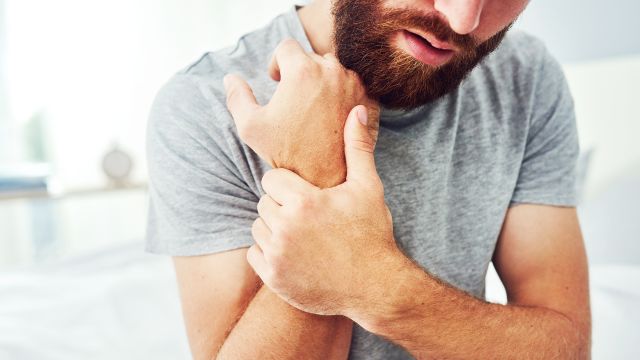Updated on April 25, 2024.
When you think of work-related injuries or occupational hazards, you may think of the black lung disease that affects coal miners or mishaps involving dangerous machinery. By comparison, wrist pain seems mild. But a case of carpal tunnel syndrome (CTS) can keep you out of work for weeks, according to the Bureau of Labor Statistics.
CTS is often thought of as a white-collar condition, but that may not be true. In fact, it hasn’t actually been proven that typing or using a computer mouse causes CTS. And it’s not just a work-related condition. You can get CTS in association with injuries, arthritis, diabetes, and even pregnancy.
What is the carpal tunnel?
To understand CTS, it helps to understand some basic facts about of human physiology.
The carpal tunnel is an inch-wide hollow space in your wrist, formed by the wrist bones and a ligament. Tendons that allow you to move your fingers, along with one of the main nerves for the hand, all run through the carpal tunnel. That nerve, known as the median nerve, provides sensation to index and middle fingers, part of the ring finger, and the thumb.
When the tunnel becomes narrow, such as when the tendons swell, pressure is applied to the nerve. Over time, this pressure can result in pain, tingling, numbness, and weakness in the hand. In severe cases, your ability to hold things using a pinch grip is weakened.
Who’s at risk for CTS?
Women and people assigned female at birth are three times more likely than men and people assigned male at birth to get CTS. Researchers think this may be because women’s wrists are usually smaller than men’s, and therefore their carpal tunnels are narrower.
Repetitive motion at work can also cause CTS, but not necessarily in the way you’d think. People who work on assembly lines seem to get CTS at higher rates than people who do jobs on computers, such as data entry. And those who work with vibrating hand tools such as drills also often develop CTS.
Other conditions associated with CTS include:
- Sprains and fractures
- Thyroid disease
- Arthritis
- Diabetes
- Pregnancy
- Pituitary gland disorders
CTS symptoms
The numbness, tingling, and pain that are the hallmarks of CTS begin gradually. They are often worse at night. Another classic indicator of CTS is waking up and needing to shake out the hand to make the symptoms stop. This is known as the “flick sign.” Sensations like these may come and go at first.
As symptoms worsen, you might also feel numbness and pain during the day while performing actions using your wrist and hand, such as talking on the phone, driving, or holding a book.
Constant numbness and weakness of the hand are often later signs of CTS. You may have difficulty performing fine motor tasks like buttoning your clothes.
Could smartphone use contribute to CTS?
Do you make heavy use a smartphone? If so, you may want to be mindful of how much time you spend typing messages on the tiny screen.
Smartphone use of four or more hours a day was linked to a higher CTS risk in one 2021 study of adults in Saudi Arabia published in Journal of Family Medicine and Primary Care. Another study published in 2022 in the Turkish Journal of Physical Medicine and Rehabilitation noted a nearly 30 percent increase in the risk of CTS with each hour increase in daily smartphone use.
Heavy use of a variety of electronic devices—including computers, smartphones, and game consoles—was linked to a thicker nerve within the carpal tunnel in a 2019 study published in Journal of Hand Surgery. This thickness may also contribute to carpal tunnel pain.
What you can do about CTS
If CTS is left untreated, nerve damage can cause the symptoms to become permanent. Fortunately, treatments are available.
One of the first treatments to try is wearing a splint to keep the hand and wrist stable and supported. Wear the splint at night at first. If symptoms persist, try wearing it during the day. If you can, try to avoid or modify activities that make the symptoms worse. Taking breaks or putting cold packs on the wrist may help.
Other treatments include heat and nonsteroidal anti-inflammatory drugs (NSAIDs) such as ibuprofen. Another option is injection therapy. Steroids injected into the wrist can help ease pressure on the nerve. Steroid pills are also an option but don’t work as well.
There’s evidence that yoga can reduce pain and improve grip strength in CTS patients. Physical therapy, including a technique called therapeutic ultrasound, may also help.
If these don’t work, you can consider carpal tunnel release surgery. This is an outpatient surgery, so no hospital stay is necessary. It involves cutting through the ligament that’s pressing on the nerve to make more room in the carpal tunnel. A surgeon will either open the wrist or do endoscopic surgery through one or two small cuts. (During an endoscopic surgery, a thin tube often containing a light, camera, and surgical tools are inserted into the body, allowing the surgeon to perform the procedure with small incisions.)
Recovery from surgery typically lasts two weeks, but it can take up to a year if you had a severe case. You’ll need to wear a splint on your wrist after the surgery and have physical therapy to strengthen the wrist and hand.
If your job puts you at risk for CTS because it involves repetitive hand movements, prevention can be tough. Use proper ergonomics at work, ask your employer about accommodations that may help you stay healthy, maintain good posture, and try simple exercises to strengthen your fingers, hands, wrists, forearms, shoulders, and neck as much as possible.







